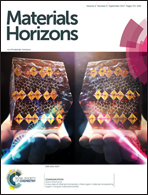Ultrathin nickel boron oxide nanosheets assembled vertically on graphene: a new hybrid 2D material for enhanced photo/electro-catalysis†
Abstract
Owing to the lack of an intrinsic driving force for two-dimensional (2D) anisotropic growth of non-layered inorganic complexes, spontaneous direct growth into a lamellar structure is considered to be an effective way to obtain ultrathin/atomically thick nanosheets. Here, we demonstrate a fast chemical synthesis, in which non-layered nickel boron oxide (Ni–Bi) in situ forms ultrathin 2D nanosheet arrays vertically aligned on both sides of graphene support, constituting a trilayered sandwich heterostructure. The realization of such an open framework heterostructure circumvents the aggregation issue and thus maximizes the exposure of the active sites of the nanosheets. In addition, the direct integration of the eletrochemically active material on conductive support ensures fast charge transport in the thickness dimension along with high structural integrity and durability. Proof-of-concept catalysis performance reveals exceptional photo/electro-catalytic reactivity and stability of the 2D-on-2D layered hybrid. This work highlights the capability and ease of fabricating ultrathin 2D heterostructures that are potentially useful for a wide range of environment-related applications.

- This article is part of the themed collections: Horizons Community Board Collection – Emerging 2D Materials for Energy and Electronics Applications and Celebrating Excellence in Research: Women of Materials Science


 Please wait while we load your content...
Please wait while we load your content...